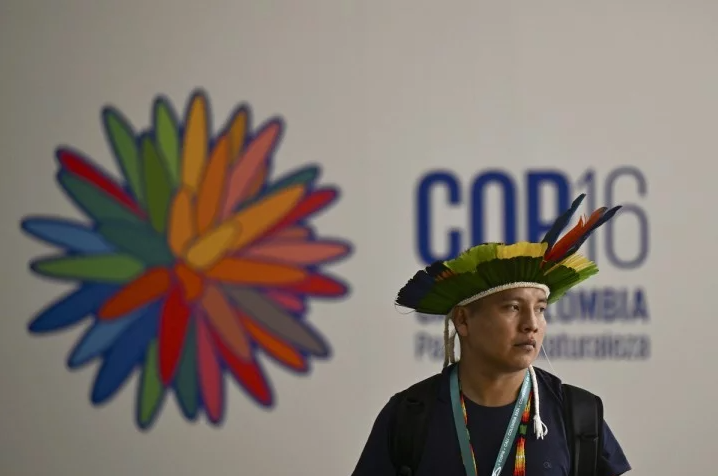The World Biodiversity Summit Begins on October 21 in Colombia: A Leading Nation in Biodiversity, Facing Major Threats
For the first time, the flags of Colombia and the United Nations (UN) are flying side by side in the city of Cali, located in southwestern Colombia. Starting Monday, October 21, the city is hosting the most significant international event ever organized in the country: the United Nations Convention on Biological Diversity (COP16). This event carries strong symbolic weight for a nation eager to reshape its global image, moving away from its past associations with drug trafficking and armed groups.
In an interview with the Colombian daily El Tiempo, Cali’s mayor, Alejandro Eder, expressed his excitement that the world is about to view the country « in a positive light. » For the next two weeks, the city will serve as an international territory of peace, welcoming states participating in the global biodiversity summit.
The Conference of the Parties on Biodiversity gathers the signatory states every two years— theoretically, all 196 UN member countries. The summit has one primary goal: to protect, restore, and sustainably manage biodiversity on a global scale. This edition, the first since the adoption of the Global Biodiversity Framework in 2022, will notably assess each country’s action plans for nature protection and reversing biodiversity loss, as well as their implementation progress.
Only 31 National Strategies Submitted
These national biodiversity strategies (NBSAPs) are required to align with the measures outlined in the Kunming-Montreal Global Biodiversity Framework, which was adopted at COP15 in Montreal in 2022. These plans serve as national tools to respond to the threats facing biological diversity. Among the 23 measures in the Framework is the goal to protect at least 30% of land and marine areas by 2030.
However, Swann Bommier, an advocacy officer at the ocean conservation organization Bloom, considers this target “too vague.” He criticizes the 2022 agreement for not providing clear guidance on how to implement this measure on the ground. « It’s easy to commit to protecting 30% of marine areas without specifying what they represent, » he argues. Bommier expects COP16 to deliver « a translation of lofty goals and vague targets into concrete, binding measures to halt biodiversity destruction. »
Currently, only 31 countries, including France, have submitted their updated strategies. At least 100 countries, however, have submitted their targets, which represent commitments to align with the 23 goals of the Global Framework. This less comprehensive document is required from countries that have not yet completed their national strategy. The World Wildlife Fund (WWF) has expressed concern over the lack of ambition seen in the few national strategies submitted so far, especially given the urgency of the situation. Its latest report reveals that global wildlife populations have declined by an average of 73% over the past fifty years.
Colombia’s Role: Turning Words into Action
Colombia will bear the responsibility of moving from words to action. The true driving force behind COP16, Colombia’s Minister of Environment, Susana Muhamad, emphasizes that Cali will not serve as a venue for “continued negotiations of commitments,” but rather for “implementing them.” As the host and a key participant, Colombia faces a dual challenge: not only proving to the world and its citizens that it can organize a major international event despite its still fragile security situation—armed groups remain active, and peace negotiations are struggling—but also demonstrating its ability to lead in environmental and biodiversity issues. Securing funding, a key focus of the negotiations, will be crucial in this effort.
Colombia’s influence also stems from its status as a “megadiverse” country, a term describing nations that harbor the majority of the planet’s biodiversity. Seventeen states, including Indonesia, China, Australia, Madagascar, and Brazil, share this distinction.
Unfortunately, these same countries also hold the grim record of being the most dangerous for environmental defenders, with Colombia leading the list, recording 79 murders in 2023. Since Global Witness began documenting these cases in 2012, 461 Colombians have lost their lives. Latin America remains the deadliest region by far. Of the 196 cases documented worldwide in 2023, 85% were in this region. Five of the deadliest countries for environmental activists that year—Colombia, Brazil, Honduras, Mexico, and Nicaragua—are in Latin America.
Colombia’s Quest for Global Recognition
Ranked as the fourth richest country in biodiversity according to the 2023 report by the National Open Data System on Biodiversity (SIB), and boasting the greatest diversity in bird, orchid, and butterfly species, Colombia is also one of the most threatened in terms of biodiversity conservation. « Colombia aims to make its voice heard and ensure that the international community clearly understands the urgency of stopping biodiversity loss, » says Sandra Vilardy, a marine biologist and environmentalist at Los Andes University and former Vice Minister of Environmental Policy for Colombia.
At the national level, the environmental policies enacted over the past two years under President Gustavo Petro appear to be moving in the right direction. Colombia became the first Latin American country to sign the Fossil Fuel Non-Proliferation Treaty at COP28 in Dubai in December 2023. The government has placed ecological transition at the core of its agenda, notably through an economic recovery plan that includes support for a greener economy and its decarbonization. “Political ecology and environmental justice have been the most serious elements of Colombia’s diplomatic conversation over the past two years,” adds Sandra Vilardy.
Source: reporterre




